FIAT SCUDO 2011 Owner handbook (in English)
Manufacturer: FIAT, Model Year: 2011, Model line: SCUDO, Model: FIAT SCUDO 2011Pages: 210, PDF Size: 3.29 MB
Page 171 of 210
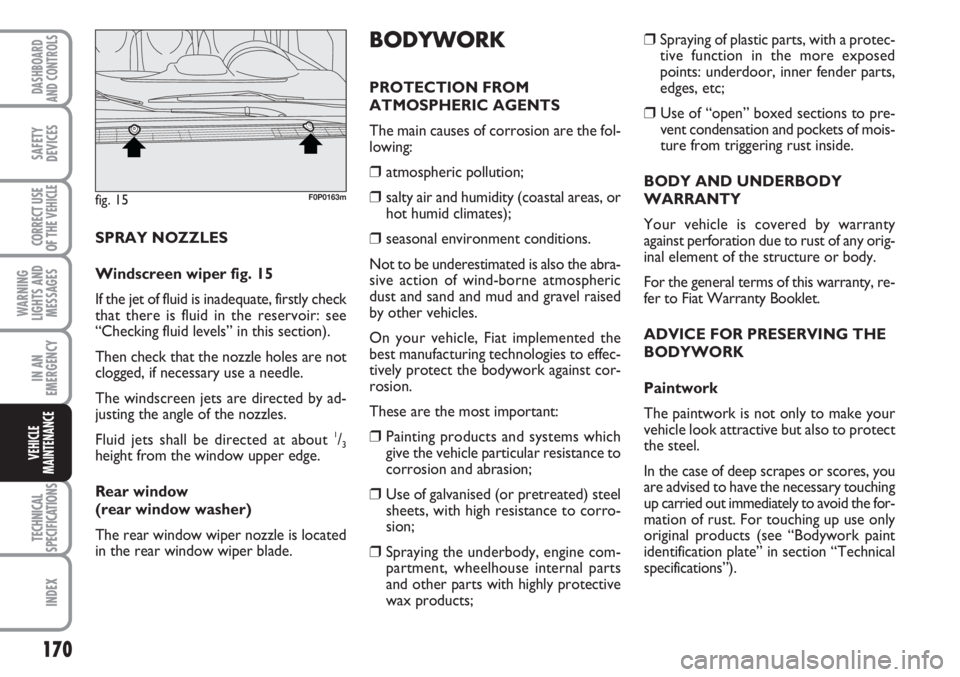
170
WARNING
LIGHTS AND
MESSAGES
TECHNICAL
SPECIFICATIONS
INDEX
DASHBOARD
AND CONTROLS
SAFETY
DEVICES
CORRECT USE
OF THE
VEHICLE
IN AN
EMERGENCY
VEHICLE
MAINTENANCE
❒Spraying of plastic parts, with a protec-
tive function in the more exposed
points: underdoor, inner fender parts,
edges, etc;
❒ Use of “open” boxed sections to pre-
vent condensation and pockets of mois-
ture from triggering rust inside.
BODY AND UNDERBODY
WARRANTY
Your vehicle is covered by warranty
against perforation due to rust of any orig-
inal element of the structure or body.
For the general terms of this warranty, re-
fer to Fiat Warranty Booklet.
ADVICE FOR PRESERVING THE
BODYWORK
Paintwork
The paintwork is not only to make your
vehicle look attractive but also to protect
the steel.
In the case of deep scrapes or scores, you
are advised to have the necessary touching
up carried out immediately to avoid the for-
mation of rust. For touching up use only
original products (see “Bodywork paint
identification plate” in section “Technical
specifications”).
BODYWORK
PROTECTION FROM
ATMOSPHERIC AGENTS
The main causes of corrosion are the fol-
lowing:
❒ atmospheric pollution;
❒ salty air and humidity (coastal areas, or
hot humid climates);
❒ seasonal environment conditions.
Not to be underestimated is also the abra-
sive action of wind-borne atmospheric
dust and sand and mud and gravel raised
by other vehicles.
On your vehicle, Fiat implemented the
best manufacturing technologies to effec-
tively protect the bodywork against cor-
rosion.
These are the most important:
❒ Painting products and systems which
give the vehicle particular resistance to
corrosion and abrasion;
❒ Use of galvanised (or pretreated) steel
sheets, with high resistance to corro-
sion;
❒ Spraying the underbody, engine com-
partment, wheelhouse internal parts
and other parts with highly protective
wax products; SPRAY NOZZLES
Windscreen wiper fig. 15
If the jet of fluid is inadequate, firstly check
that there is fluid in the reservoir: see
“Checking fluid levels” in this section).
Then check that the nozzle holes are not
clogged, if necessary use a needle.
The windscreen jets are directed by ad-
justing the angle of the nozzles.
Fluid jets shall be directed at about
1/3height from the window upper edge.
Rear window
(rear window washer)
The rear window wiper nozzle is located
in the rear window wiper blade.
fig. 15F0P0163m
Page 172 of 210
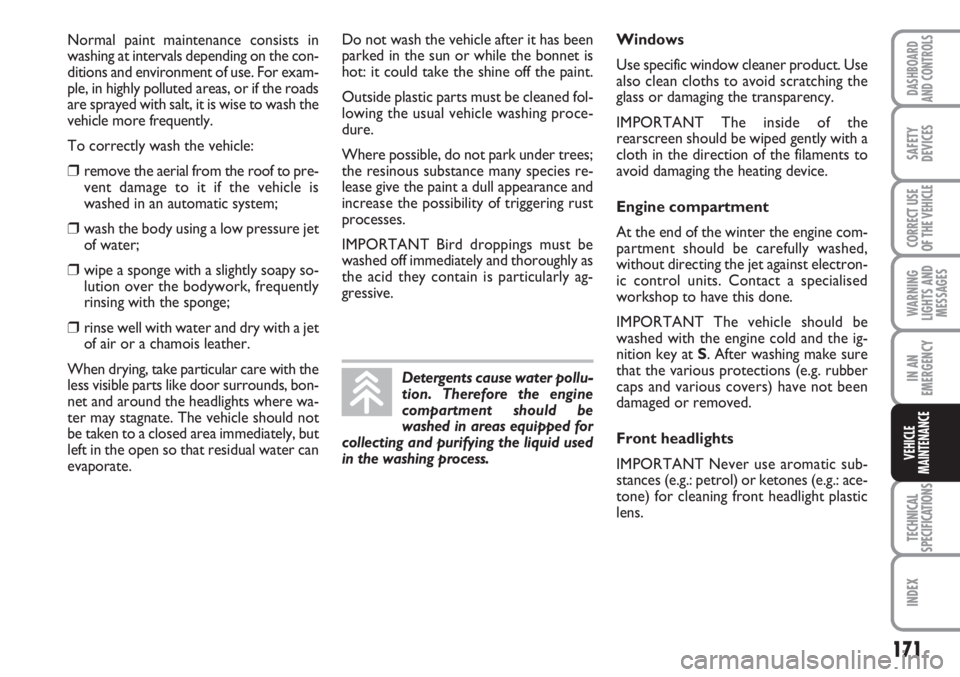
171
WARNING
LIGHTS AND
MESSAGES
TECHNICAL
SPECIFICATIONS
INDEX
DASHBOARD
AND CONTROLS
SAFETY
DEVICES
CORRECT USE
OF THE
VEHICLE
IN AN
EMERGENCY
VEHICLE
MAINTENANCE
Normal paint maintenance consists in
washing at intervals depending on the con-
ditions and environment of use. For exam-
ple, in highly polluted areas, or if the roads
are sprayed with salt, it is wise to wash the
vehicle more frequently.
To correctly wash the vehicle:
❒ remove the aerial from the roof to pre-
vent damage to it if the vehicle is
washed in an automatic system;
❒ wash the body using a low pressure jet
of water;
❒ wipe a sponge with a slightly soapy so-
lution over the bodywork, frequently
rinsing with the sponge;
❒ rinse well with water and dry with a jet
of air or a chamois leather.
When drying, take particular care with the
less visible parts like door surrounds, bon-
net and around the headlights where wa-
ter may stagnate. The vehicle should not
be taken to a closed area immediately, but
left in the open so that residual water can
evaporate.Do not wash the vehicle after it has been
parked in the sun or while the bonnet is
hot: it could take the shine off the paint.
Outside plastic parts must be cleaned fol-
lowing the usual vehicle washing proce-
dure.
Where possible, do not park under trees;
the resinous substance many species re-
lease give the paint a dull appearance and
increase the possibility of triggering rust
processes.
IMPORTANT Bird droppings must be
washed off immediately and thoroughly as
the acid they contain is particularly ag-
gressive.
Detergents cause water pollu-
tion. Therefore the engine
compartment should be
washed in areas equipped for
collecting and purifying the liquid used
in the washing process.
Windows
Use specific window cleaner product. Use
also clean cloths to avoid scratching the
glass or damaging the transparency.
IMPORTANT The inside of the
rearscreen should be wiped gently with a
cloth in the direction of the filaments to
avoid damaging the heating device.
Engine compartment
At the end of the winter the engine com-
partment should be carefully washed,
without directing the jet against electron-
ic control units. Contact a specialised
workshop to have this done.
IMPORTANT The vehicle should be
washed with the engine cold and the ig-
nition key at S. After washing make sure
that the various protections (e.g. rubber
caps and various covers) have not been
damaged or removed.
Front headlights
IMPORTANT Never use aromatic sub-
stances (e.g.: petrol) or ketones (e.g.: ace-
tone) for cleaning front headlight plastic
lens.
Page 173 of 210
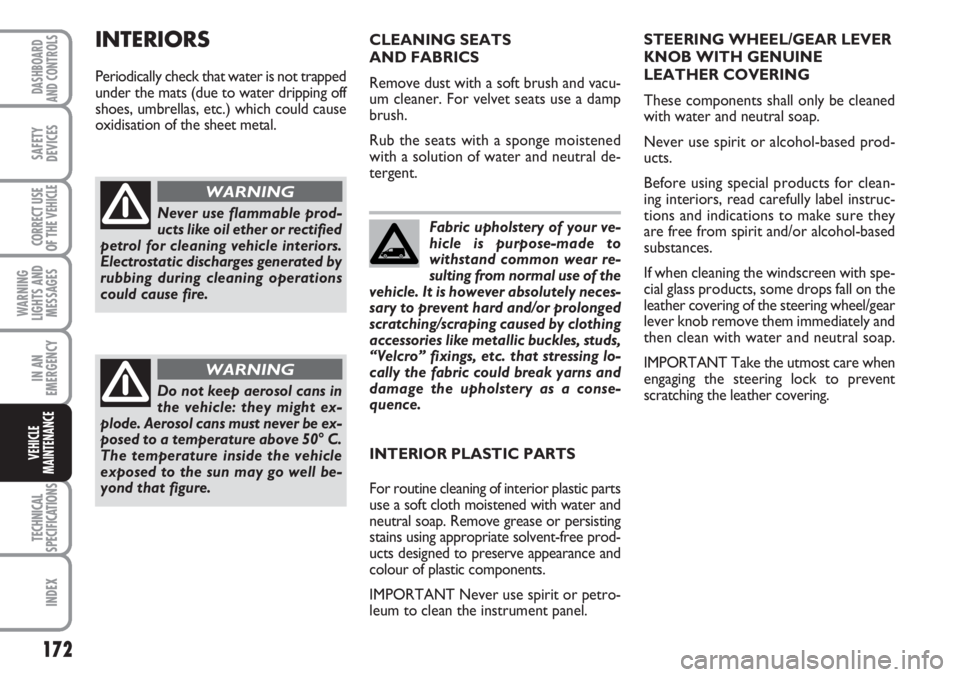
172
WARNING
LIGHTS AND
MESSAGES
TECHNICAL
SPECIFICATIONS
INDEX
DASHBOARD
AND CONTROLS
SAFETY
DEVICES
CORRECT USE
OF THE
VEHICLE
IN AN
EMERGENCY
VEHICLE
MAINTENANCE
Fabric upholstery of your ve-
hicle is purpose-made to
withstand common wear re-
sulting from normal use of the
vehicle. It is however absolutely neces-
sary to prevent hard and/or prolonged
scratching/scraping caused by clothing
accessories like metallic buckles, studs,
“Velcro” fixings, etc. that stressing lo-
cally the fabric could break yarns and
damage the upholstery as a conse-
quence. CLEANING SEATS
AND FABRICS
Remove dust with a soft brush and vacu-
um cleaner. For velvet seats use a damp
brush.
Rub the seats with a sponge moistened
with a solution of water and neutral de-
tergent.Never use flammable prod-
ucts like oil ether or rectified
petrol for cleaning vehicle interiors.
Electrostatic discharges generated by
rubbing during cleaning operations
could cause fire.
WARNING
Do not keep aerosol cans in
the vehicle: they might ex-
plode. Aerosol cans must never be ex-
posed to a temperature above 50° C.
The temperature inside the vehicle
exposed to the sun may go well be-
yond that figure.
WARNING
INTERIORS
Periodically check that water is not trapped
under the mats (due to water dripping off
shoes, umbrellas, etc.) which could cause
oxidisation of the sheet metal.STEERING WHEEL/GEAR LEVER
KNOB WITH GENUINE
LEATHER COVERING
These components shall only be cleaned
with water and neutral soap.
Never use spirit or alcohol-based prod-
ucts.
Before using special products for clean-
ing interiors, read carefully label instruc-
tions and indications to make sure they
are free from spirit and/or alcohol-based
substances.
If when cleaning the windscreen with spe-
cial glass products, some drops fall on the
leather covering of the steering wheel/gear
lever knob remove them immediately and
then clean with water and neutral soap.
IMPORTANT Take the utmost care when
engaging the steering lock to prevent
scratching the leather covering.
INTERIOR PLASTIC PARTS
For routine cleaning of interior plastic parts
use a soft cloth moistened with water and
neutral soap. Remove grease or persisting
stains using appropriate solvent-free prod-
ucts designed to preserve appearance and
colour of plastic components.
IMPORTANT Never use spirit or petro-
leum to clean the instrument panel.
Page 174 of 210
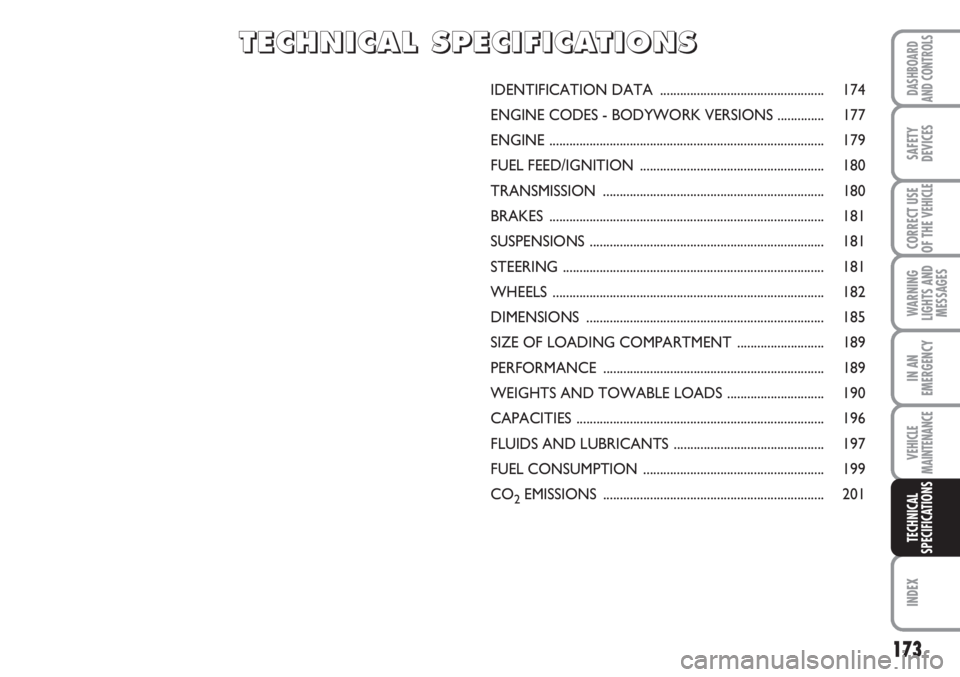
173
WARNING
LIGHTS AND
MESSAGES
INDEX
DASHBOARD
AND CONTROLS
SAFETY
DEVICES
CORRECT USE
OF THE
VEHICLE
IN AN
EMERGENCY
VEHICLE
MAINTENANCE
TECHNICAL
SPECIFICATIONS
IDENTIFICATION DATA ................................................. 174
ENGINE CODES - BODYWORK VERSIONS .............. 177
ENGINE .................................................................................. 179
FUEL FEED/IGNITION ....................................................... 180
TRANSMISSION .................................................................. 180
BRAKES .................................................................................. 181
SUSPENSIONS ...................................................................... 181
STEERING .............................................................................. 181
WHEELS ................................................................................. 182
DIMENSIONS ....................................................................... 185
SIZE OF LOADING COMPARTMENT .......................... 189
PERFORMANCE .................................................................. 189
WEIGHTS AND TOWABLE LOADS ............................. 190
CAPACITIES .......................................................................... 196
FLUIDS AND LUBRICANTS ............................................. 197
FUEL CONSUMPTION ...................................................... 199
CO
2EMISSIONS .................................................................. 201
T T
E E
C C
H H
N N
I I
C C
A A
L L
S S
P P
E E
C C
I I
F F
I I
C C
A A
T T
I I
O O
N N
S S
Page 175 of 210
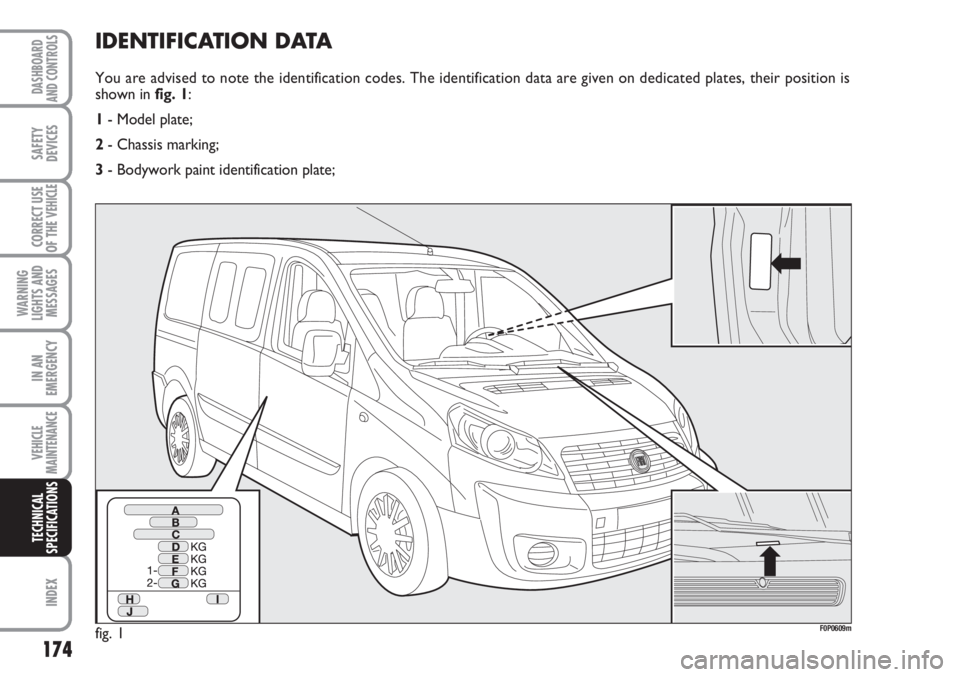
174
WARNING
LIGHTS AND
MESSAGES
INDEX
DASHBOARD
AND CONTROLS
SAFETY
DEVICES
CORRECT USE
OF THE
VEHICLE
IN AN
EMERGENCY
VEHICLE
MAINTENANCE
TECHNICAL
SPECIFICATIONS
IDENTIFICATION DATA
You are advised to note the identification codes. The identification data are given on dedicated plates, their position is
shown in fig. 1:
1- Model plate;
2- Chassis marking;
3- Bodywork paint identification plate;
fig. 1F0P0609m
Page 176 of 210
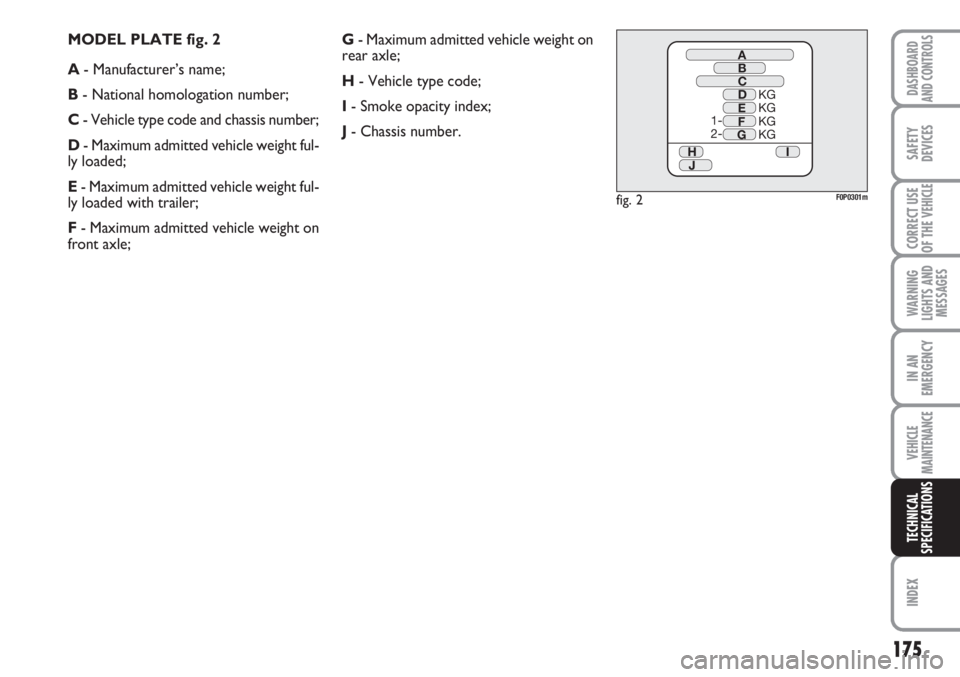
175
WARNING
LIGHTS AND
MESSAGES
INDEX
DASHBOARD
AND CONTROLS
SAFETY
DEVICES
CORRECT USE
OF THE
VEHICLE
IN AN
EMERGENCY
VEHICLE
MAINTENANCE
TECHNICAL
SPECIFICATIONS
MODEL PLATE fig. 2
A- Manufacturer’s name;
B- National homologation number;
C- Vehicle type code and chassis number;
D- Maximum admitted vehicle weight ful-
ly loaded;
E- Maximum admitted vehicle weight ful-
ly loaded with trailer;
F- Maximum admitted vehicle weight on
front axle;G- Maximum admitted vehicle weight on
rear axle;
H- Vehicle type code;
I- Smoke opacity index;
J- Chassis number.
fig. 2
A
B
C
D
E
F
G
H
JI 1-
2-KG
KG
KG
KG
F0P0301m
Page 177 of 210
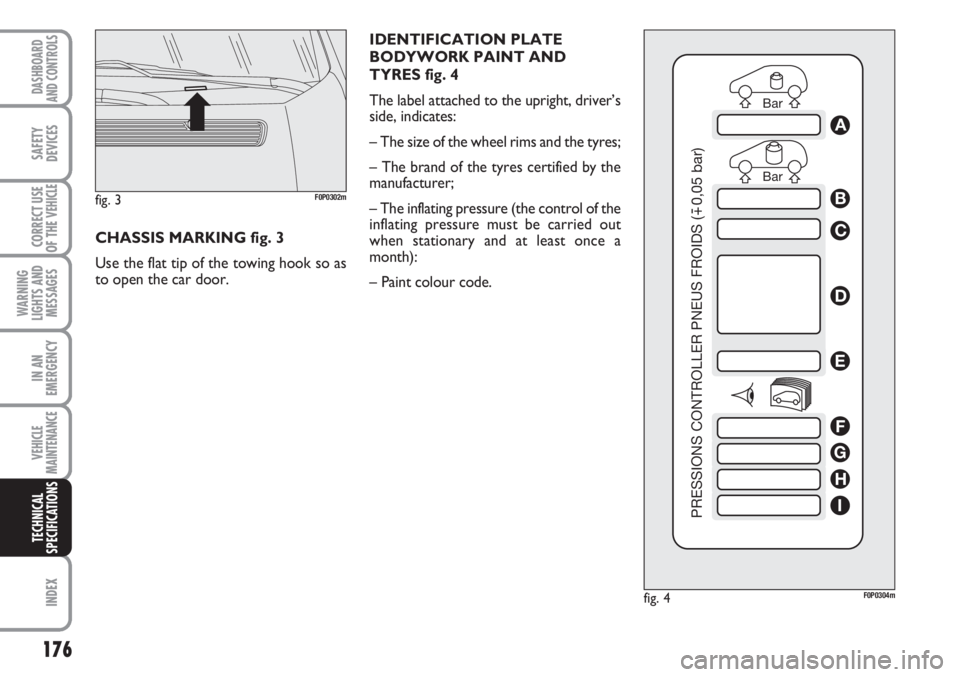
IDENTIFICATION PLATE
BODYWORK PAINT AND
TYRES fig. 4
The label attached to the upright, driver’s
side, indicates:
– The size of the wheel rims and the tyres;
– The brand of the tyres certified by the
manufacturer;
– The inflating pressure (the control of the
inflating pressure must be carried out
when stationary and at least once a
month):
– Paint colour code.
176
WARNING
LIGHTS AND
MESSAGES
INDEX
DASHBOARD
AND CONTROLS
SAFETY
DEVICES
CORRECT USE
OF THE
VEHICLE
IN AN
EMERGENCY
VEHICLE
MAINTENANCE
TECHNICAL
SPECIFICATIONS
fig. 4
Bar Bar
PRESSIONS CONTROLLER PNEUS FROIDS (
0,05 bar)
A
B
C
D
E
F
G
H
I
F0P0304m
CHASSIS MARKING fig. 3
Use the flat tip of the towing hook so as
to open the car door.
fig. 3F0P0302m
Page 178 of 210
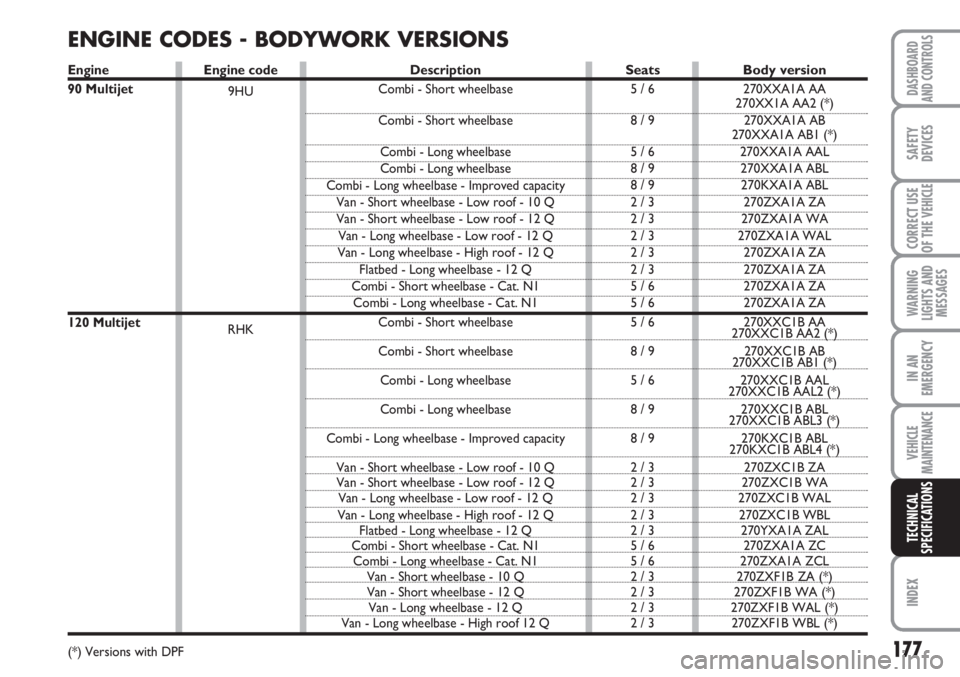
177
WARNING
LIGHTS AND
MESSAGES
INDEX
DASHBOARD
AND CONTROLS
SAFETY
DEVICES
CORRECT USE
OF THE
VEHICLE
IN AN
EMERGENCY
VEHICLE
MAINTENANCE
TECHNICAL
SPECIFICATIONS
ENGINE CODES - BODYWORK VERSIONS
Engine code
9HU
RHKDescription
Combi - Short wheelbase
Combi - Short wheelbase
Combi - Long wheelbase
Combi - Long wheelbase
Combi - Long wheelbase - Improved capacity
Van - Short wheelbase - Low roof - 10 Q
Van - Short wheelbase - Low roof - 12 Q
Van - Long wheelbase - Low roof - 12 Q
Van - Long wheelbase - High roof - 12 Q
Flatbed - Long wheelbase - 12 Q
Combi - Short wheelbase - Cat. N1
Combi - Long wheelbase - Cat. N1
Combi - Short wheelbase
Combi - Short wheelbase
Combi - Long wheelbase
Combi - Long wheelbase
Combi - Long wheelbase - Improved capacity
Van - Short wheelbase - Low roof - 10 Q
Van - Short wheelbase - Low roof - 12 Q
Van - Long wheelbase - Low roof - 12 Q
Van - Long wheelbase - High roof - 12 Q
Flatbed - Long wheelbase - 12 Q
Combi - Short wheelbase - Cat. N1
Combi - Long wheelbase - Cat. N1
Van - Short wheelbase - 10 Q
Van - Short wheelbase - 12 Q
Van - Long wheelbase - 12 Q
Van - Long wheelbase - High roof 12 QBody version
270XXA1A AA
270XX1A AA2 (*)
270XXA1A AB
270XXA1A AB1 (*)
270XXA1A AAL
270XXA1A ABL
270KXA1A ABL
270ZXA1A ZA
270ZXA1A WA
270ZXA1A WAL
270ZXA1A ZA
270ZXA1A ZA
270ZXA1A ZA
270ZXA1A ZA
270XXC1B AA
270XXC1B AA2 (*)
270XXC1B AB
270XXC1B AB1 (*)
270XXC1B AAL
270XXC1B AAL2 (*)
270XXC1B ABL
270XXC1B ABL3 (*)
270KXC1B ABL
270KXC1B ABL4 (*)
270ZXC1B ZA
270ZXC1B WA
270ZXC1B WAL
270ZXC1B WBL
270YXA1A ZAL
270ZXA1A ZC
270ZXA1A ZCL
270ZXF1B ZA (*)
270ZXF1B WA (*)
270ZXF1B WAL (*)
270ZXF1B WBL (*)
Seats
5 / 6
8 / 9
5 / 6
8 / 9
8 / 9
2 / 3
2 / 3
2 / 3
2 / 3
2 / 3
5 / 6
5 / 6
5 / 6
8 / 9
5 / 6
8 / 9
8 / 9
2 / 3
2 / 3
2 / 3
2 / 3
2 / 3
5 / 6
5 / 6
2 / 3
2 / 3
2 / 3
2 / 3
Engine
90 Multijet
120 Multijet
(*) Versions with DPF
Page 179 of 210
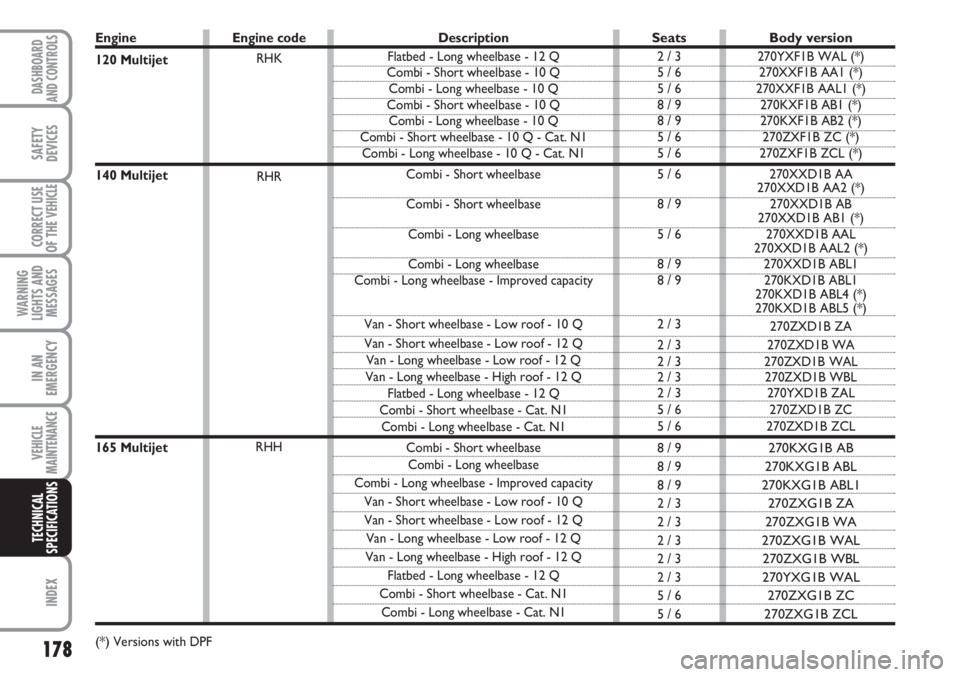
178
WARNING
LIGHTS AND
MESSAGES
INDEX
DASHBOARD
AND CONTROLS
SAFETY
DEVICES
CORRECT USE
OF THE
VEHICLE
IN AN
EMERGENCY
VEHICLE
MAINTENANCE
TECHNICAL
SPECIFICATIONS
Engine
120 Multijet
140 Multijet
165 Multijet
(*) Versions with DPF
Seats
2 / 3
5 / 6
5 / 6
8 / 9
8 / 9
5 / 6
5 / 6
5 / 6
8 / 9
5 / 6
8 / 9
8 / 9
2 / 3
2 / 3
2 / 3
2 / 3
2 / 3
5 / 6
5 / 6
8 / 9
8 / 9
8 / 9
2 / 3
2 / 3
2 / 3
2 / 3
2 / 3
5 / 6
5 / 6 Engine code
RHK
RHR
RHHDescription
Flatbed - Long wheelbase - 12 Q
Combi - Short wheelbase - 10 Q
Combi - Long wheelbase - 10 Q
Combi - Short wheelbase - 10 Q
Combi - Long wheelbase - 10 Q
Combi - Short wheelbase - 10 Q - Cat. N1
Combi - Long wheelbase - 10 Q - Cat. N1
Combi - Short wheelbase
Combi - Short wheelbase
Combi - Long wheelbase
Combi - Long wheelbase
Combi - Long wheelbase - Improved capacity
Van - Short wheelbase - Low roof - 10 Q
Van - Short wheelbase - Low roof - 12 Q
Van - Long wheelbase - Low roof - 12 Q
Van - Long wheelbase - High roof - 12 Q
Flatbed - Long wheelbase - 12 Q
Combi - Short wheelbase - Cat. N1
Combi - Long wheelbase - Cat. N1
Combi - Short wheelbase
Combi - Long wheelbase
Combi - Long wheelbase - Improved capacity
Van - Short wheelbase - Low roof - 10 Q
Van - Short wheelbase - Low roof - 12 Q
Van - Long wheelbase - Low roof - 12 Q
Van - Long wheelbase - High roof - 12 Q
Flatbed - Long wheelbase - 12 Q
Combi - Short wheelbase - Cat. N1
Combi - Long wheelbase - Cat. N1
Body version
270YXF1B WAL (*)
270XXF1B AA1 (*)
270XXF1B AAL1 (*)
270KXF1B AB1 (*)
270KXF1B AB2 (*)
270ZXF1B ZC (*)
270ZXF1B ZCL (*)
270XXD1B AA
270XXD1B AA2 (*)
270XXD1B AB
270XXD1B AB1 (*)
270XXD1B AAL
270XXD1B AAL2 (*)
270XXD1B ABL1
270KXD1B ABL1
270KXD1B ABL4 (*)
270KXD1B ABL5 (*)
270ZXD1B ZA
270ZXD1B WA
270ZXD1B WAL
270ZXD1B WBL
270YXD1B ZAL
270ZXD1B ZC
270ZXD1B ZCL
270KXG1B AB
270KXG1B ABL
270KXG1B ABL1
270ZXG1B ZA
270ZXG1B WA
270ZXG1B WAL
270ZXG1B WBL
270YXG1B WAL
270ZXG1B ZC
270ZXG1B ZCL
Page 180 of 210
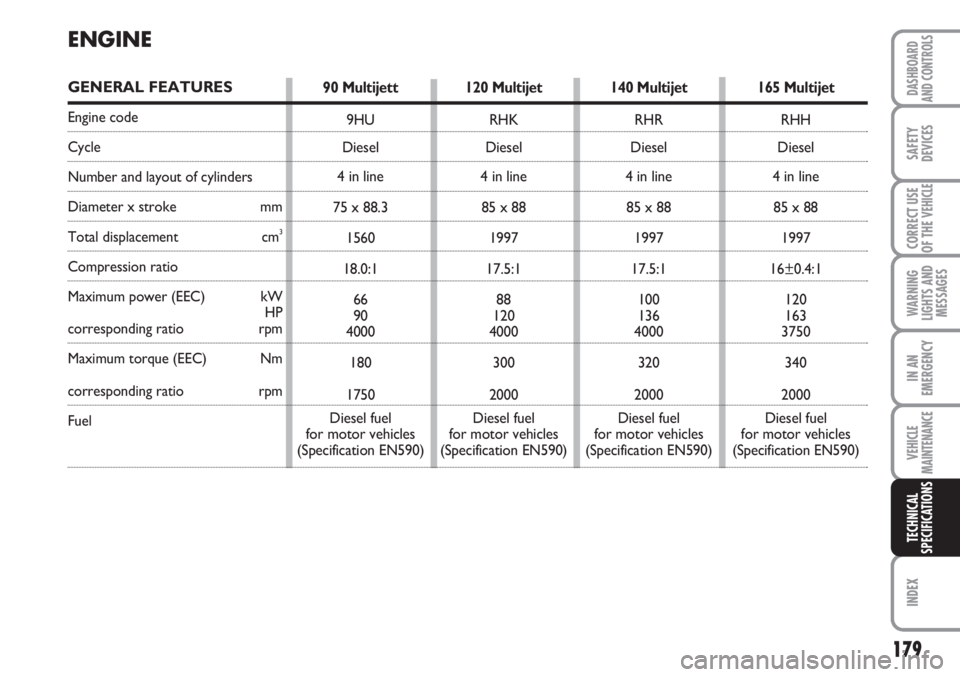
179
WARNING
LIGHTS AND
MESSAGES
INDEX
DASHBOARD
AND CONTROLS
SAFETY
DEVICES
CORRECT USE
OF THE
VEHICLE
IN AN
EMERGENCY
VEHICLE
MAINTENANCE
TECHNICAL
SPECIFICATIONS
ENGINE
GENERAL FEATURES
Engine code
Cycle
Number and layout of cylinders
Diameter x stroke mm
Total displacement cm3
Compression ratio
Maximum power (EEC) kW
HP
corresponding ratio rpm
Maximum torque (EEC) Nm
corresponding ratio rpm
Fuel
90 Multijett
9HU
Diesel
4 in line
75 x 88.3
1560
18.0:1
66
90
4000
180
1750
Diesel fuel
for motor vehicles
(Specification EN590)
120 Multijet
RHK
Diesel
4 in line
85 x 88
1997
17.5:1
88
120
4000
300
2000
Diesel fuel
for motor vehicles
(Specification EN590)
140 Multijet
RHR
Diesel
4 in line
85 x 88
1997
17.5:1
100
136
4000
320
2000
Diesel fuel
for motor vehicles
(Specification EN590)
165 Multijet
RHH
Diesel
4 in line
85 x 88
1997
16±0.4:1
120
163
3750
340
2000
Diesel fuel
for motor vehicles
(Specification EN590)